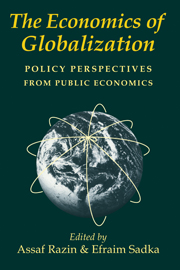Book contents
- Frontmatter
- Contents
- Preface
- List of Contributors
- Introduction
- I International Mobility of Technology
- II Capital Flows and Exchange-Rate Misalignment
- III Tax Incentives and Patterns of Capital Flows
- IV Limits to Income Redistribution in Federal Systems
- 6 Income Redistribution in an Economic Union: The Trade-off Between International and Intranational Redistributions
- 7 Federal Insurance of U.S. States: An Empirical Investigation
- V Tax Harmonization, Tax Coordination, and the “Disappearing Taxpayer”
- VI Political-Economy Aspects of International Tax Competition
- VII Migration of Skilled and Unskilled Labor
- VIII Fiscal Aspects of Monetary Unification
- Index
7 - Federal Insurance of U.S. States: An Empirical Investigation
Published online by Cambridge University Press: 28 January 2010
- Frontmatter
- Contents
- Preface
- List of Contributors
- Introduction
- I International Mobility of Technology
- II Capital Flows and Exchange-Rate Misalignment
- III Tax Incentives and Patterns of Capital Flows
- IV Limits to Income Redistribution in Federal Systems
- 6 Income Redistribution in an Economic Union: The Trade-off Between International and Intranational Redistributions
- 7 Federal Insurance of U.S. States: An Empirical Investigation
- V Tax Harmonization, Tax Coordination, and the “Disappearing Taxpayer”
- VI Political-Economy Aspects of International Tax Competition
- VII Migration of Skilled and Unskilled Labor
- VIII Fiscal Aspects of Monetary Unification
- Index
Summary
Introduction
States participating in a federation can increase their welfare by mutually insuring idiosyncratic output risk. Such insurance can be obtained through transactions on capital markets, through cross-border ownership of productive assets, or via the tax-transfer system of the central government of the federation. Asdrubali, Sφrensen, and Yosha (1996) quantified the relative importance of the main channels through which risk sharing occurs among the 50 U.S. states. They found that when the United States is viewed as one integrated market, 39% of shocks to gross state product are insured, on average, by capital markets, and 13% are insured by the federal tax-transfer system. Further consumption smoothing through saving and dis-saving smooths 23% of shocks to output (about half of the uninsured component of income), and 25% of shocks are not smoothed.
In this chapter we investigate in greater detail the channels through which the federal government provides income insurance to U.S. states. In particular, we focus on federal taxes and transfers (e.g., unemployment contributions and benefits) and grants to states. Interest in the insurance role of central fiscal institutions has increased in recent years because of the debate on the European Monetary Union (EMU). In the absence of mechanisms for achieving income insurance and consumption smoothing, countries in recession will have an incentive to leave that union. It is often claimed that cross-country income insurance provided by central fiscal institutions is essential for the stability of a monetary union.
- Type
- Chapter
- Information
- The Economics of GlobalizationPolicy Perspectives from Public Economics, pp. 156 - 170Publisher: Cambridge University PressPrint publication year: 1999
- 2
- Cited by



